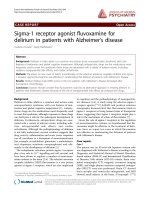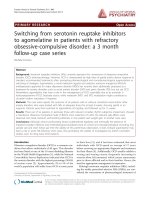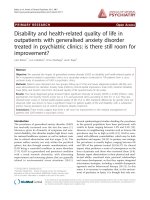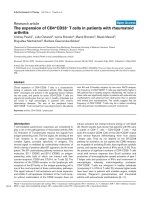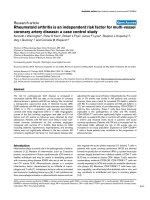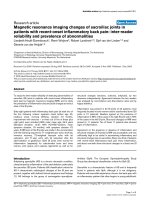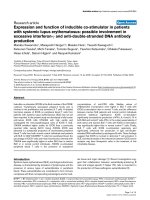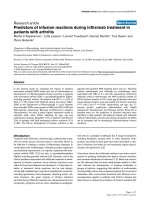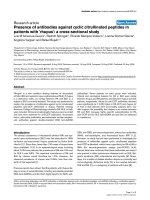Báo cáo y học: "Preliminary speech recognition results after cochlear implantation in patients with unilateral hearing loss: a case series." pdf
Bạn đang xem bản rút gọn của tài liệu. Xem và tải ngay bản đầy đủ của tài liệu tại đây (371.79 KB, 6 trang )
CAS E REP O R T Open Access
Preliminary speech recognition results after
cochlear implantation in patients with unilateral
hearing loss: a case series
Yvonne Stelzig
1*
, Roland Jacob
1
and Joachim Mueller
2
Abstract
Introduction: Cochlear implants known to provide support in individuals with bilateral hearing loss may also be of
great benefit for individuals with unilateral hearing loss. This case report demonstrates the positive effects of
cochlear implantation on speech understanding in noise conditions in patients with unilateral hearing loss and
normal hearing on the contralateral side. To the best of our knowledge, the data presented here are from the first
few cases to receive a cochlear implant for unilateral hearing loss.
Case presentation: Four Caucasian German men, two aged 48 and the others aged 51 and 57 years old, with
post-lingual unilateral hearing loss and normal hearing on the contralateral side were implanted with a cochlear
implant. All our patients were members of the German army. Before and after implantation, they were given a
battery of speech tests in different hearing conditions to assess the effect of unilateral cochlear implantation on
speech understanding in noise conditions. Test results showed that all patients benefited from unilateral cochlear
implantation, particularly in terms of speech understanding in noise conditions.
Conclusions: Unilateral cochlear implantation might be a successful treatment method for patients with unilateral
hearing loss not benefiting from alternative treatment options. The results of this case report open up the field of
cochlear implantation for expanded criteria and new areas of research.
Introduction
Many individuals with unilateral hearing loss (UHL)
have genuine difficulties in understanding speech in
noise conditions. Despite these impediments, the impact
of a complete UHL is often minimized by the presence
of (near) normal hearing (NH) on the contralateral side.
However, different studies have shown that the normal
hearing capabilities of these individuals do no t compen-
sate for their UHL [1]. Lin et al. [2] addressed the audi-
tory deficits of patients with UHL. They rep orted that
monaural patients had the greatest difficulties when the
sound or source of speech was localized on the hearing
impaired side, presumably due to the reduced exploita-
tion of binaural processes.
Although it is recognized that patients with UHL
encounter problems in speech recognition in noise
conditions or sound localization, only very few treat-
ment methods are available to these patients [1]. Cur-
rently, they are generally treated with contralateral
routing of signals (CROS) hearing aids [3] or bo ne-
anchored hearing aid (BAHA) implants [4]. However,
various studies have demonstrated a p oor user satisfac-
tion of CROS as well as only a minimal improvement in
speech discrimination in noise conditions and none for
sound localization with the BAHA implant [2,5].
In contrast to these treatment options for UHL, bilat-
era l HL is mainly treat ed by cochlear implantation. The
effectiveness of bilateral cochlear implants (CIs) has
been demonstrated in th e last several years [6,7].
Patients with bilateral CIs show better speech discrimi-
nation largely due to the exploitation of the head sha-
dow effect (with the head obstructing noise sources
from the receiving ear), the binaural summation effect
(receiving redundant information at both ears) and the
squelch effect (occurring due to temporal and spectral
differences of spatially separated speech and noise
* Correspondence:
1
Department of Oto-Rhino-Laryngology, Central Army Hospital Koblenz,
Ruebenacher Str. 170, 56072 Koblenz, Germany
Full list of author information is available at the end of the article
Stelzig et al. Journal of Medical Case Reports 2011, 5:343
/>JOURNAL OF MEDICAL
CASE REPORTS
© 2011 Stelzig et al; license e BioMed Central Ltd. This is an Open Access article distributed under the terms of the Creative Commons
Attribution License ( w hich permits unrestricted use, distribution, and reproduction in
any medium, provided the original work is properly cited.
sources) [8]. According to Schleich et al. [9], bilater al CI
users significantly benef it from head shadow, squelch
and summation effects, substantially improving their
performance of speech understanding in noise condi-
tions. These results may also s uggest that individuals
with UHL could gain substantial benefi t from CIs due
to added binaural effects as shown in a tinnitus study by
Vermeire et al. [10].
Case presentation
Patient S1 w as a 48-year- old Caucasian German man
with post-lin gual UHL and NH on his contralateral ear.
The etiology of his hearing loss was unknown, and his
middle ear status was normal. He had a duration of
deafness of 11 months before unilateral implantation
with a CI. Patient S2 was a 51-year-old Caucasian Ger-
man man also with post-lingual UHL and NH on his
contralateral ear. His hearing loss was caused by acous-
tic trauma; his middle ear status was reported to be nor-
mal. Patient S2 had a duration of deafness of 45 months
before unilateral CI implantation. Patient S3 was a 48-
year -old Caucasian German man with post-lingual UHL
and NH on his contralateral ear. He had lost his hearing
due to a stapedectomy; he showed a normal middle ear
status. Patient S3 was implanted unilaterally with a CI
after a duration of deafness of 96 months. Patient S4
was a 57-year-old Caucasian German man with post-lin-
gual UHL and NH on his contralateral ear. His hearing
loss was due to a Borrelia infection. Patient S4 also
showed a normal middle ear status and was implanted
with a CI after a duration of hearing loss of 33 months.
Our patients did not wear hearing aids (HAs) before
implantation as their hearing loss (HL) was too pro-
found f or HAs to provide sufficient acoustic amplifica-
tion. Since all our patients were members of the
German Army, which is obliged by law to provide the
best possible compensation for any kind of disability,
treatment costs were no issue. Our patients, who all had
leading positions within the army, consistently reported
a high level of distress often related to feelings that their
job was at risk because of their HL and were thus highly
motivated for CI treatment. All our patients w ere thor-
oughly counseled and signed informed consent before
implantation. Authorization was provided by the Ger-
many Army, as our patients were treated in an army
hospital in Germany.
All our patients were implanted with the PUL-
SARCI
100
implant and a standard electrode of 31.5 mm
in length (MED-EL, Innsbruck, Austria). Our patients
also received the OPUS 2 speech processor including
the FineStructure coding strategy. In all patients, first
fitting of the CI was performed approximately four
weeks after implantation and included the adjustment of
electrical hearing thresholds, the most comfortable
stimulation levels as well a s frequency allocation and
compression characteristics. Our patients received aural
rehabilitation therapy for patie nts with CI in their hear-
ing centers. Bil ateral testing was pe rformed once a
monosyllable understanding in quiet conditions of 50%
correctness was achieved.
Pure tone audiometry testing was performed in the
NH ear, in the hearing impaired ear before CI implanta-
tion and, post-operatively, in the CI-only condition six
months after first fitting. During testing i n the CI-only
condition, the contralateral ear was plugged and masked
with 80 dB wideband noise. All our patients had NH on
the contralateral side with mean hearing thresholds of 5
dB to 30 dB HL across tested frequencies (250 kHz to 8
kHz). Pre-operatively, our patients showed pure tone
thresholds averaging between 80 dB and 100 dB in the
hearing impaired side (Figure 1). Pure tone audiometry
after six months of implant use showed that hearing
thresholds were stable in the implanted side and ranged
from 25 dB to 45 dB HL (Figure 2).
In the speech tests, our patients were tested with their
normal everyday processor settings, which were
obtained during clinical device fitting when the implant
was first fitted, and our patients subsequently adjusted
the loudness to a comfortable level. Tests were per-
formed in an audiometric room with a semicircular
loudspeaker set-up. A total of 11 WESTRA audiometry
loudspeakers were mounted on a steel ring of 2 m dia-
meter at a height of 1.2 m above the mesh in the frontal
horizontal plane from 90° (right) to -90° (left) and with
a s eparation of 18°. Our patients were positioned on an
adjustable chair in the center of the semicircle of loud-
speakers. All tests, the tested conditions and the time of
testing are displayed in Table 1. Test conditions
included the acoustic-only (CI side with speech proces-
sorturnedoffandNHsideunpluggedandunmasked),
binaural (NH and CI side ) and CI-only (CI side only
with contralateral ear plugged and masked with 80 dB
wideband noise) conditions.
0
20
40
60
80
100
120
250 500 1000 2000 3000 4000 6000 8000
F
requency
[H
z
]
HL [dB]
S1
S2
S3
S4
NR
Figure 1 Individual hearing thresholds of deaf sides before
implantation.
Stelzig et al. Journal of Medical Case Reports 2011, 5:343
/>Page 2 of 6
The Freiburg monosyllable test [11] (20 lists, 20
monosyllable words per list) was presented at a sound
pressure level (SPL) of 65 dB SPL. Stimuli were pre-
sented from the front in quiet c onditions and at a sig-
nal-to-noise ratio (SNR) of 15 dB, 5 dB and 0 dB, and
speech simulating CCITT (Comite Consultatif Interna-
tional Telegraphique et Telephonique) noise was pre-
sented from the front (same loudspeaker). The test was
performed in acoustic-only, binaural and CI-only condi-
tions. Monosyllable scores in the CI-only condition are
shown in Figure 3. After six months, our patients scored
between 70% and 80% (mean: 75%). The individual
monosyllable scores for binaural and acoustic-only con-
ditions are shown in Figure 4. C onsistent ceiling effects
were observed in quiet conditions for both the acoustic-
only and binaural conditions. A consistent increase in
speech understanding in the binaural condition com-
pared to the acoustic-only condition was found at all
three SNR levels: the mean benefit at 15 dB SNR was
3.8 percentage points (pp), at 5 dB SNR 7.5 pp and at 0
dB SNR 11.9 pp (Figure 4).
The dichotic listening test [12] included 10 number
groups of which each contained 10 two-digit number
pairs that were presented simultaneously at 80 dB SPL
via loudspeakers. The use of loudspeakers deviated from
the original test design suggested by Feldmann [12] and
was selected to emphasize the impact of the head sha-
dow effect and binaural hearin g. This test was per-
formed in acoustic-only, binaural and CI-only
conditions. Dichotic speech test results are depicted in
Figure 5. Scores ranged from 60% to 80% (mean: 71.3%)
acoustic-only, 20% to 30% (mean: 23.8%) with CI-only
(with contral ateral ear plugge d and masked) and 80% to
100% (mean: 90%) in the binaural condition. The m ean
benefit in the binaural condition compared to the acous-
tic-only condition was 18.8 pp.
The Hochmair-Schulz-Mose r (HSM) sentence test
[13] (30 lists of 20 sentences three to eight words long,
each list consisting of 106 words) was presented at 65
dBSPLwithaSNRof10dB,0dBand-5dB.Thetest
was performed in acoustic-only and binau ral conditions.
Individual HSM scores in the binaural and acoustic-only
conditions are shown in Figure 6. Ceiling effects were
observed at 10 dB SNR. At 0 dB SNR and -5 dB SNR,
the HSM scores of all our patients were higher in the
binaural condition compared to the acoustic-only
0
10
20
30
40
50
60
250 500 1000 2000 3000 4000 6000 8000
HL
[dB]
S1
S2
S3
S4
Frequency [Hz]
Figure 2 Individual hearing thresholds in the cochlear implant
(CI)-only condition after six months of implant use. The
contralateral ear was plugged and masked with 80 dB broadband
noise.
Table 1 Test overview
S1 S2 S3 S4
Monosyllable test; CI-only* 6666
Monosyllable test; acoustic-only and binaural* 22 11 14 12
HSM; acoustic-only and binaural* 22 11 14 12
OLSA; acoustic-only and binaural* 22 11 14 12
Dichotic listening test, CI-only, acoustic-only and binaural* 3333
Audiogram of normal hearing ear Pre-operative Pre-operative Pre-operative Pre-operative
Audiogram of hearing impaired ear (acoustic-only) Pre-operative Pre-operative Pre-operative Pre-operative
Audiogram of implanted ear (CI-only)* 6666
*All time given in months of device use.
CI = cochlear implant; HL = hearing loss; HSM = Hochmair-Schulz-Moser test; OLSA = Oldenburg Sentence Test.
0
10
20
30
40
50
60
70
80
90
100
S
1
S
2
S3 S
4
S
core [
%
]
CI-only
Figure 3 Freiburg monosyllable test scores in the cochlear
implant (CI)-only condition with stimuli presented at 65 dB
sound pressure level (SPL) in quiet conditions on the CI side,
with the contralateral ear plugged and masked, after six
months of implant use.
Stelzig et al. Journal of Medical Case Reports 2011, 5:343
/>Page 3 of 6
condition with a mean increase in speech understanding
of 4.6 pp at 0 dB SNR and of 6.3 pp at -5 dB SNR.
The Oldenburg Se ntence Test (OLSA) [14] (30 sen-
tences, five words per sentence) was modified by pre-
senting speech from various azimuth conditions, that is,
speech was presented either from the front, contralateral
CI or ipsilateral CI. The noise was presented from the
frontanditslevelwasconstant(60dBSPL),whereas
the speech level was varied adaptively. For each test run,
individual speech reception thresholds (SRTs) were cal-
culated by averaging the signal level s of the last 20 sen-
tences in each list and subtra cting the noise level of 60
dB SPL. The test was performed i n acoustic-only and
binaural conditions. Each condition (listening and azi-
muth conditions) was tested twice in a randomized
order. Individual SRTs measured with the OLSA a re
shown in Figure 7. Our patients performed best when
the noise signal was presented on the CI side (-9.3 dB
binaural, -9.2 dB acoustic-only) and worst when the
noise was presented on the contralateral side (-4.7 dB
binaural, -4.3 dB acoustic-only). With noise presented
from the front, our patient s performed slightly better
than in the contralateral presentation (-5.0 dB with CI,
-4.8 dB acoustic-only). Mean differences between listen-
ing conditions were less than 0.4 dB for all noise source
placements.
Discussion
Specific testing decisions were taken considering the
dichotic listening test, whose design deviated from the
original test layout [12] by using loudspeakers instead of
headphones. Thus, we could focus not only on the per-
ception of two highly separated sounds but also on head
shadow and binaural effects. The positive results of this
test suggest that unilaterally implanted patients may
benefit from a reduced head shadow, which in t his case
obstructed speech sources from the hearing ear, as well
0
10
20
30
40
50
60
70
80
90
100
Quiet
15dB
5dB
0dB
Quiet
15dB
5dB
0dB
Quiet
15dB
5dB
0dB
Quiet
15dB
5dB
0dB
S1 S2 S3 S4
Score [%]
Acoustic-only
Binaural
Figure 4 Freiburg monosyllable test scores in binaural and
acoustic-only conditions with stimuli presented at 65 dB sound
pressure level (SPL) in quiet conditions and at different signal-
to-noise ratios (SNRs) with stimuli (and CCITT noise) presented
from the front, with the contralateral ear unplugged and
unmasked.
0
10
20
30
40
50
60
70
80
90
100
S
1
S
2
S
3
S
4
S
core [
%
]
Acoustic-only
Binaural
CI-only
Figure 5 Individual dichotic two-digit number scores at 80 dB
sound pressure level (SPL): acoustic-only, binaural and
cochlear implant (CI)-only (contralateral ear plugged and
masked) conditions three months after first fitting with signals
presented from -90° and 90°.
0
10
20
30
40
50
60
70
80
90
100
10 dB
0 dB
-5 dB
10 dB
0 dB
-5 dB
10 dB
0 dB
-5 dB
10 dB
0 dB
-5 dB
S1 S2 S3 S4
S
core [
%
]
Acoustic-only
Binaural
Figure 6 Individual Hochmair-Schulz-Moser (HSM) sentence
tests scores at 65 dB sound pressure level (SPL) at different
signal-to-noise ratios (SNRs) (CCITT noise) presented from the
front in binaural and acoustic-only conditions, with the
contralateral ear unplugged and unmasked.
-14
-12
-10
-8
-6
-4
-2
0
NcontraCI
Nfornt
Nips iCI
NcontraCI
Nfornt
Nips iCI
NcontraCI
Nfornt
Nips iCI
NcontraCI
Nfornt
Nips iCI
S1 S2 S3 S4
SRT [dB]
Acoustic-only
Binaural
N
contraCI = Noise
p
resented contralateral CI; Nfront = Noise
p
resented from front; Ni
p
siCI = Noise
p
resented i
p
silateral C
I
Figure 7 Mean Oldenburg Sentence Test (OLSA) speech
reception thresholds (SRTs) at 60 dB sound pressure level
(SPL) noise level and adaptive speech in binaural and acoustic-
only conditions, with speech presented from the front and
noise presented from front, contralateral cochlear implant (CI)
and ipsilateral CI. NcontraCI = noise presented contralateral CI;
Nfront = noise presented from front; NipsiCI = noise presented
ipsilateral CI.
Stelzig et al. Journal of Medical Case Reports 2011, 5:343
/>Page 4 of 6
as from binaural effects known for NH individuals or
bilateral CI users and the ab ility to integrate indepen-
dent inputs on both sides.
The results of all speech tests demonstrate that
patients benefit from binaural hearing when compared
to the acoustic-only or CI-only conditions. However,
due to the small number of patients tested, conclusions
about the statistical significance cannot be drawn.
To obtain a tendency of the subjective percep tion, we
used a visual analog scale (VAS), ranging from 0 (very
low) to 10 (very high). Our patients stated a h igh level
of CI acceptance, integration of CI hearing, increased
ease of listening especially in noise situations and a
regaining of acoustic orientation abilities. After our
patients became accustomed to the CI sound, they also
rated the quality of the sound signals generated by the
CI to be good. No negative interference of NH when
using the CI was reported. This can probably be attribu-
ted to advancing CI technology having developed mod-
ern coding strategies with high frequency resolution and
temporal processing. Ove rall, the subje ctive ratings of
theCIweremorepositivethanresultsoftheobjective
testing.
It should be emphasized, however, that the VAS was
not validated, but shows a tendency of how the CI is
perceived. It must furthermore be stated that the subjec-
tive results might possibly be influenced by psychologi-
cal effects, such as our patients’ high motivation and
expectations towards CI implantation. It might thus be
interesting for future studies to focus in greater detail
on the subjective benefits of unilateral CIs in particular,
as well as on possible psychological ef fects influencing
the subjective perception.
This contrast between objective and subjective benefits
might also be due to the fact that the speech tests are
designed for b ilateral HL and not for NH on the con-
tralateral side. The results in the acoustic-only condition
might be dominated by the NH ear, thus decreasing the
measurable difference between acoustic-only and
binaural test results. A further explanation might be
that all our patients reported improved sound localiza-
tion abilities, which, however, cannot be f ully reflected
in speech tests, even if two separate ly placed speech
sources are used. It would be an attractive aspect for
future unilateral CI studies to include localization tests
and to investigate if subjective and objective results con-
tinue to s how different lev els of improv ement. Further-
more, future studies should include a greater subject
population and adapted speech tests focusing on unilat-
eral hearing so that statistical significance can be
demonstrated.
Our patients in the present study had profound UHL
for which HAs would not have rendered sufficient
acoustic amplification. Since all our patients were
members of the German army, treatme nt costs were no
issue; however, generally, cost effectiveness plays an
important role in health care structures. Regardless,
based on the results of studies by Bond et al. [15], for
example, the decision of unilateral cochlear implantation
should not be influenced or even restrained by cost-
related arguments.
Conclusions
Our patients showed a small but important benefit from
unilateral cochlear implantation in speech recognition in
noise c onditions. The subjective benefits suggest a h igh
degree of integration of the artificial auditory input
through the CI. Restored sound localization and a
regained spatial awareness were also reported and might
be of interest in future research.
Consent
Written informed consent was obtained from the
patients for publication of this case report and any
accompanying images. A copy of the written consent is
available for review by the Editor-in-Chief of this
journal.
Author details
1
Department of Oto-Rhino-Laryngology, Central Army Hospital Koblenz,
Ruebenacher Str. 170, 56072 Koblenz, Germany.
2
Department of Oto-Rhino-
Laryngology, Plastic, Aesthetic and Reconstructive Head and Neck Surgery,
University of Wuerzburg, Josef-Schneider-Str. 11, 97080 Wuerzburg, Germany.
Authors’ contributions
All authors contributed to the manuscript and reviewed, edited and
approved the final report.
Competing interests
The authors declare that they have no competing interests.
Received: 9 August 2010 Accepted: 2 August 2011
Published: 2 August 2011
References
1. Sargent E, Herrmann B, Hollenbeak C, Bankaitis A: The minimum speech
test battery in profound unilateral hearing loss. Otol Neurotol 2001,
22:480-486.
2. Lin L-M, Bowditch S, Anderson MJ, May B, Cox KM, Niparko JK:
Amplification in the rehabilitation of unilateral deafness: Speech in noise
and directional hearing effects with bone-anchored hearing and
contralateral routing of signal amplification. Otol Neurotol 2006,
27:172-182.
3. Harford E, Barry J: A rehabilitative approach to the problem of unilateral
hearing impairment: the contralateral routing of signals CROS. J Speech
Hear Disord 1965, 30:121-138.
4. Bosman AJ, Hol MK, Snik AD, Mylanus AM, Cremers CW: Bone-anchored
hearing aids in unilateral inner ear deafness. Acta Otolaryngol 2003,
123:258-260.
5. Niparko JK, Cox KM, Lustig LR: Comparison of the bone anchored hearing
aid implantable hearing device with contralateral routing of offside
signal amplification in the rehabilitation of unilateral inner ear deafness.
Otol Neurotol 2003, 24:73-78.
6. Schoen F, Mueller J, Helms J: Speech reception thresholds obtained in a
symmetrical four-loudspeaker arrangement from bilateral users of MED-
EL cochlear implants. Otol Neurotol 2002, 23:710-714.
Stelzig et al. Journal of Medical Case Reports 2011, 5:343
/>Page 5 of 6
7. Laske RD, Veraguth D, Dillier N, Binkert A, Holzmann D, Huber AM:
Subjective and objective results after bilateral cochlear implantation in
adults. Otol Neurotol 2009, 30:313-318.
8. Das S, Buchman CA: Bilateral cochlear implantation: current concepts.
Curr Opin Otolaryngol Head Neck Surg 2005, 13:290-293.
9. Schleich P, Nopp P, D’Haese P: Head shadow, squelch, and summation
effects in bilateral users of the MED-EL COMBI 40/40+ cochlear implant.
Ear Hear 2004, 25:197-204.
10. Vermeire K, Van de Heyning P: Binaural hearing after cochlear
implantation in subjects with unilateral sensorineural deafness and
tinnitus. Audiol Neurootol 2009, 14:163-171.
11. Hahlbrock KH: Sprachaudiometrie. 2 edition. Stuttgart, Germany: Georg
Thieme Verlag; 1970.
12. Feldmann H: Dichotic Discrimination Test, a new method for the
diagnosis of central hearing disorders. Arch Ohren Nasen Kehlkopfheilkd
1965, 184:294-329.
13. Hochmair-Desoyer I, Schulz E, Moser L, Schmidt M: The HSM sentence test
as a tool for evaluating the speech understanding in noise of cochlear
implant users. Am J Otol 1997, 18:83.
14. Wagener K, Kuehnel V, Kollmeier B: Entwicklung und Evaluation eines
Satztests fuer die deutsche Sprache I: Design des Oldenburger Satztests.
Z Audiol 1999, 1:4-15.
15. Bond M, Elston J, Mealing S, Anderson R, Weiner G, Taylor R, Stein K:
Systematic reviews of the effectiveness and cost-effectiveness of multi-
channel unilateral cochlear implants for adults. Clin Otolaryngol 2010,
35:87-96.
doi:10.1186/1752-1947-5-343
Cite this article as: Stelzig et al.: Preliminary speech recognition results
after cochlear implantation in patients with unilateral hearing loss: a
case series. Journal of Medical Case Reports 2011 5:343.
Submit your next manuscript to BioMed Central
and take full advantage of:
• Convenient online submission
• Thorough peer review
• No space constraints or color figure charges
• Immediate publication on acceptance
• Inclusion in PubMed, CAS, Scopus and Google Scholar
• Research which is freely available for redistribution
Submit your manuscript at
www.biomedcentral.com/submit
Stelzig et al. Journal of Medical Case Reports 2011, 5:343
/>Page 6 of 6
